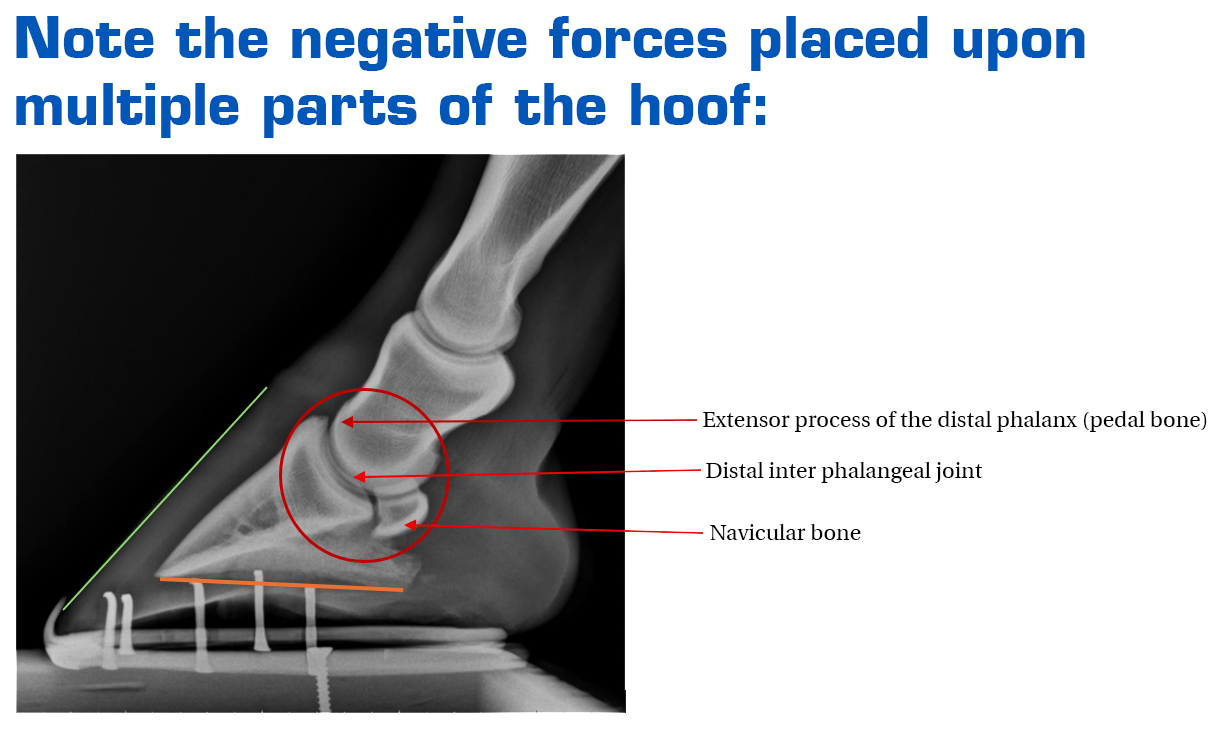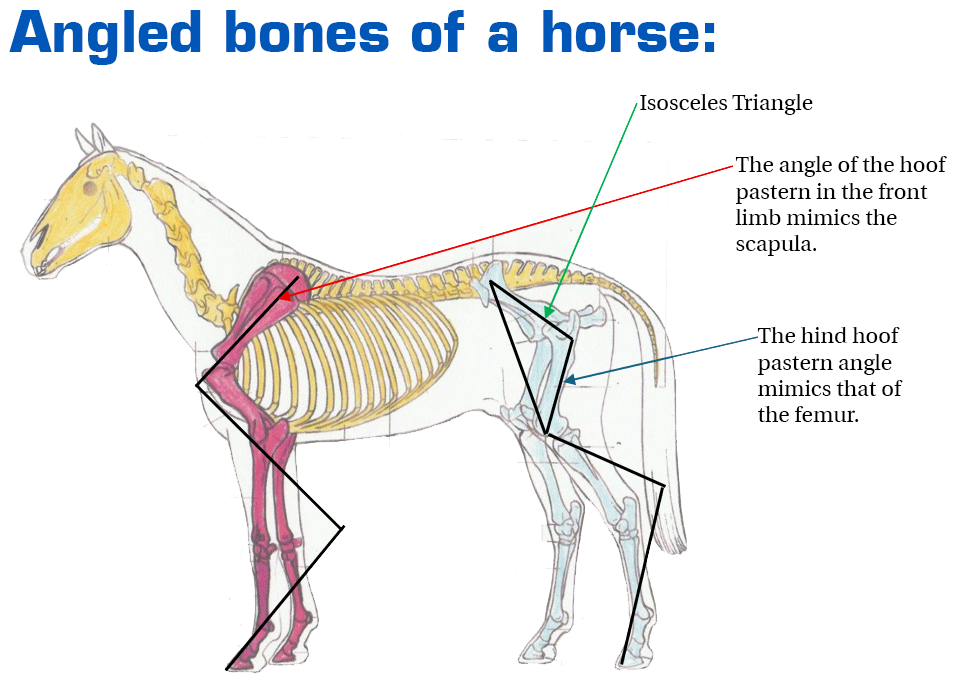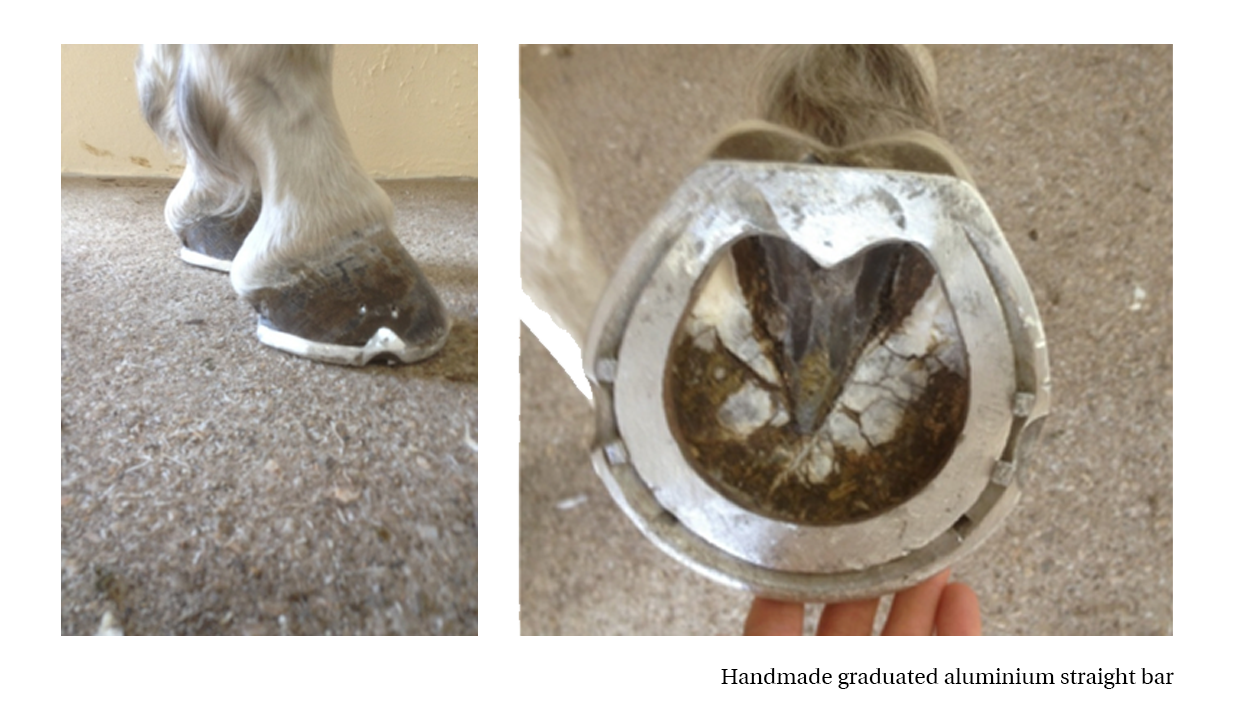The Importance Of Maintaining Correct Hoof Pastern Angle
Many people who take up farriery do so out of necessity in Australia. Sometimes it may be that they are in a remote area like on a station in the outback, or because they have trouble getting a trained professional out to their property. In some cases, people just desire to learn to shoe or trim their own horse. Whatever the reason, farriery is not regulated in Australia, so there is nothing stopping anyone from going the DIY route.
However, we must always remember that the horse is a living creature, and although it may look easy watching a trained professional working on a horse, proper hoofcare, especially shoeing, is not a simple process. Any person who is not trained or skilled has the capacity to unintentionally cause lameness and/or serious injury, so understanding the anatomy of the hoof, and how to care for the horse properly, is key prior to undertaking any farriery tasks.
The Role Of A Farrier
The role of a farrier is simple – to provide the horse with a sound platform. This is the first thing all farriery students must learn, and the key word here is sound. Put simply, this means that the horse should be able to walk, trot, and perform its required tasks comfortably once trimming or shoeing is complete, unless there's an underlying issue unrelated to the hoof.
Far too often throughout my career I have seen farriers and trimmers who just pick up a horse’s foot and trim it without looking at the horse as a whole. This can lead to over trimming, a common mistake that can quickly lame a horse, however not attending to the horses’ feet on a regular basis can cause the hooves to grow out of balance as well.
The point I am making here is that we are meant to shoe the horse not just the foot!
Hoof Health And Horse Speed
Relative to their size, horses are one of the fastest animals on the planet. The reason for this is that the angled bones in both the front and hind limbs allow them to absorb shock and redistribute that force into propulsion. Therefore, the correct alignment of these angled bones is imperative to allow a horse to perform at high speeds without suffering injury.
For example, too long of a toe from overgrowth or lack of regular maintenance would result in more stress being placed on the deep digital flexor tendon & navicular area of that horse. That being said, it is also important not to over correct, and we must also consider the medial lateral aspects of balance to ensure we are correctly aligning the bones on that plane too.
Below is a radiograph of a horse with too much toe resulting in a negative hoof pastern alignment. Note the orange line indicating a negative palmar angle, red circle showing the misalignment of the distal inter phalangeal joint and the area of extra pressure placed on the navicular bursa and bone as the deep digital flexor tendon passes over it.
Additional Shock Absorbers
Although the angled bones of a horse are a driving factor in allowing the horse to absorb concussion and redistribute that force into propulsion, it is important to mention the other ways a horse naturally absorbs concussion. These additional shock absorbers are synovial joints, synovial fluid, articular cartilage, tendons, ligaments, a correctly functioning hoof and blood. Blood may seem an odd inclusion on this list, however, within a functional hoof blood acts as a kind of hydraulic buffer. As the fetlock descends, the blood within the hoof activates the hoof concussion absorbing mechanisms, therefore supporting all other aspects of shock absorption.
All of these factors working together help the horse to move at speed without injury. This is why it is so important from a farrier’s perspective that we try to keep all these bones, joints, tendons, ligaments and the hoof as a whole aligned so as not to cause injury.
Why A Good Hoof Pastern Angle Alignment Is Key
The importance of good hoof pastern alignment cannot be overstated, as it is key to preventing injury and maintaining the equine athlete at peak performance. In almost all farrier books you will notice that hoof pastern alignment is mentioned, yet not all drawn illustrations are accurate, and some books fail to include the hind limbs. Due to this, it is crucial to make sure that the information you are looking at is correct, and seek a secondary source if you are at all unsure.
Hoof Issues Caused By A Bad Hoof Pastern Angle Alignment
You will notice that when discussing shock absorption above, I said a functional hoof. The hoof when aligned with the bones will function as it is supposed to, but if it is out of alignment, we see issues that show us that the hoof is not functioning correctly, such as low heels, corns, an atrophied frog and so on.
From a medio/lateral aspect we see sheared heels, corns and quarter cracks when a horse is out of alignment. Often in these cases we need to look at the initial cause which may be some form of angular limb deformity when assessing how we trim or shoe to align the bones.
However, when we get things right and maintain the angles on a regular rotation, we counter any adverse effects. This at the end of the day makes us more productive, in that we don’t have to fix problems as well as giving the horse better longevity.
The above image shows the angled bones in the horse: in red the thoracic limb showing scapula angle mimic the lower bones and hoof capsule, in blue you see the femur mimic the lower bones and hoof capsule.
Remember when you attend your horses, always take the time to assess them and don’t allow yourself to become the person who just trims or shoes a foot. Learn more about the anatomy and biomechanics of the horse and become a person who shoes the whole horse! This will set you apart from the others that don’t, and you will have far less problems at the end of the day.
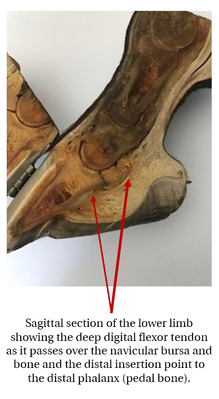 |
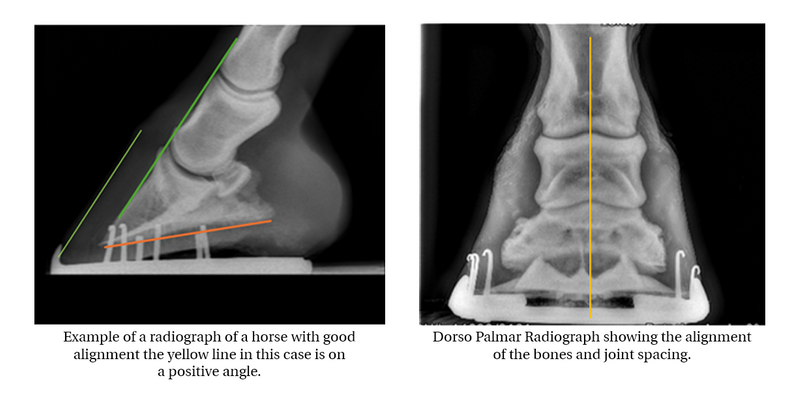 |
Tips For Success
Schedule An Appropriate Shoeing Cycle
In most articles I write I always mention regular trimming or shoeing intervals as this corresponds with the growth rate of the horse’s hoof.
When we shoe a horse, it provides traction and protects the hoof from excessive wear. Due to this, we need to regularly remove the shoe and trim any excessive growth thus realigning the hoof pastern angle, this is the key role of the farrier.
We have to consider the growth rate of the horse’s hoof, which is subject to change due to environment and other factors, however on average a horse’s foot grows at a rate of 6mm to 8mm per month. Hence the importance of regular shoeing intervals.
Research undertaken by Professor Renate Weller in 2016 found that for every centimeter of toe length in the average thoroughbred, 50 kilograms of force is applied to the tendons. It is for this reason in my practice I usually shoe high performance horses like thoroughbreds and standard bred race horses on a 4-week rotation.
Most other breeds I shoe on a 5-week rotation depending on the horses work load and rate of growth. This will vary seasonally and according to work cycles, thus I am always assessing the horses every time I shoe or trim and making adjustments accordingly.
Focus On Trimming First
Trimming is one of the most important aspects of shoeing horses, this is where we as farriers or trimmers have the chance to realign the horse’s hoof both in terms of
However, there are many times that we cannot take any more toe off a horse without hitting sensitive tissue or making the foot sore, in these cases trimming alone does not prove sufficient, so we need to have the skills to provide a solution and still realign the horse.
Facilitate BreakoverSetting a shoe back under the horse’s toe is one solution, by using side clips (or no clips) we can roll the toe of the shoe and set it back under the toe facilitating better break over and easing the pressure on the heels thus better aligning the horse. A shoe that is made to assist this method is an equilibrium. The advantage of an equilibrium or a rolled toe shoe is that the toe is thinner and wears at a faster rate, this helps the toe to wear at the same rate as the hoof grows and facilitates better breakover thus the hoof capsule will normalise faster. |
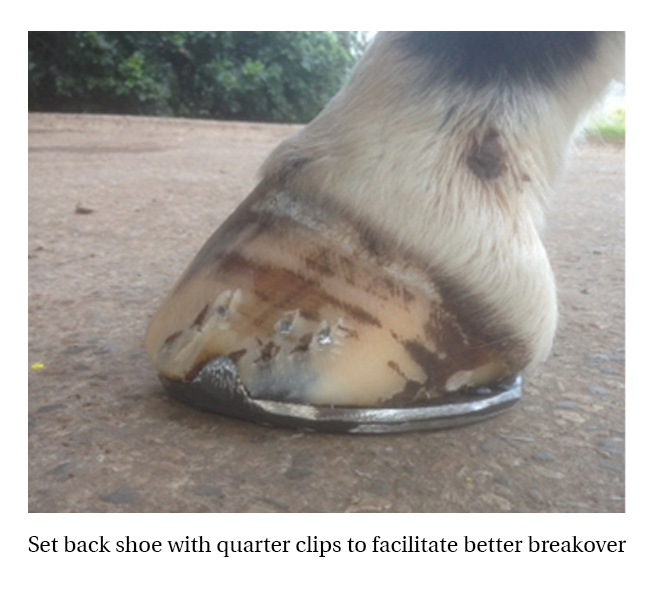 |
Select The Right Therapeutic Horseshoes
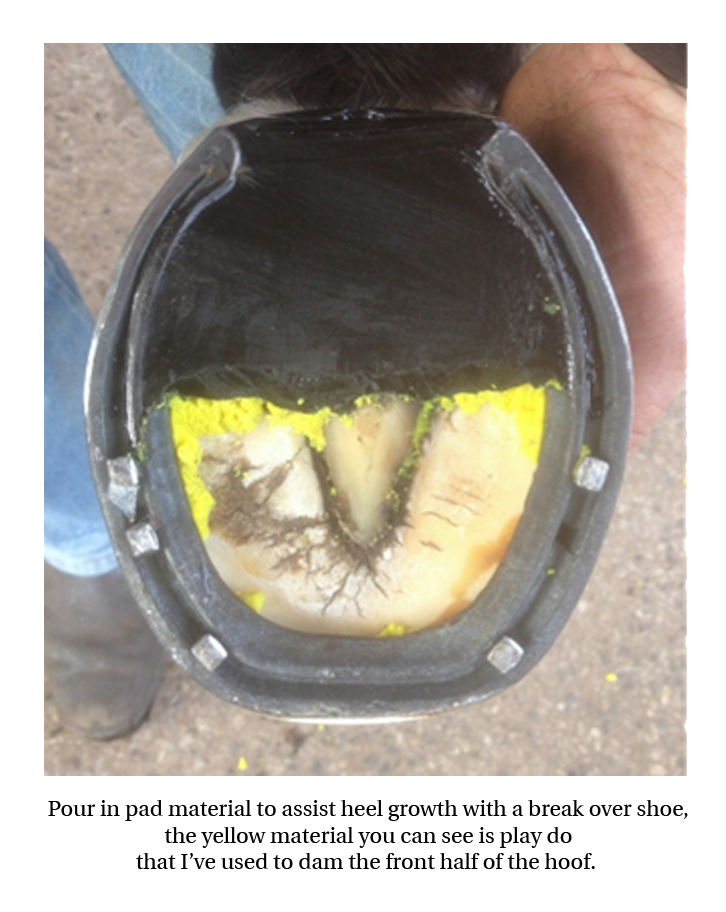 |
Wedged HeelsOften farriers choose to apply open heel wedged shoes in an attempt to normalize (hoof pastern angle). The problem I have found with this is that this option is not suitable long term, as the wedge shoe without any digital support crushes the horses’ heels more, as such it is not my usual go to option. The point here is that digital support such as ComfortMix pad material or similar when used in conjunction with a wedge heel shoe will assist in normalising the angle. |
Wedged 3D Pads
3D pads are one of the new tools a farrier can adopt to help rectify an abnormal or negative hoof pastern angle. I have used these pads in conjunction with Dental Impression Material (DIM) to normalise horses with negative angles both in front and hind limbs with great success. The benefit I believe with this method is that it allows the hoof to grow more heel, thus normalising the hoof capsule and facilitating stronger heels. The benefit of this method is that, in many cases, it only has to be used until the hoof normalises, as it supports the horse in growing a hoof that can easily carry the animal.
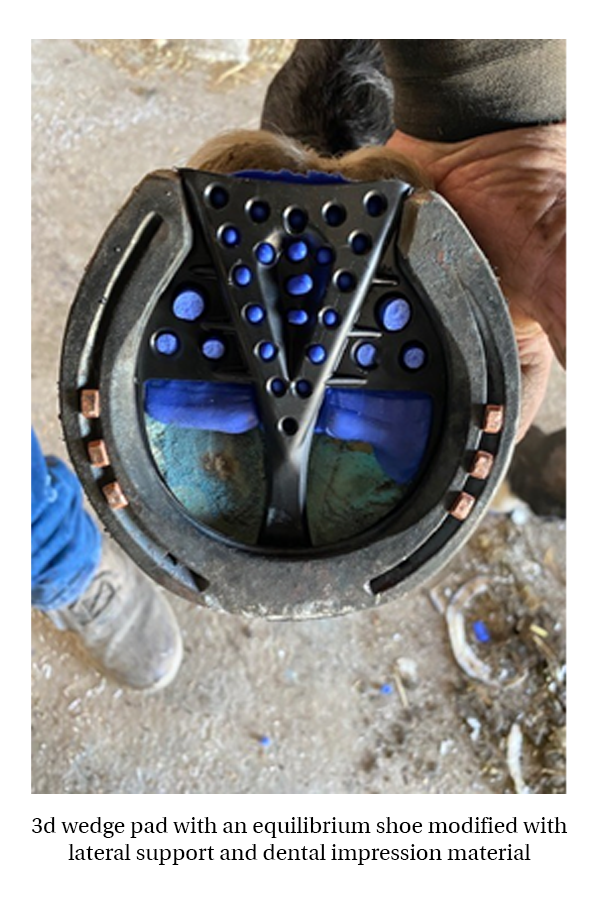 |
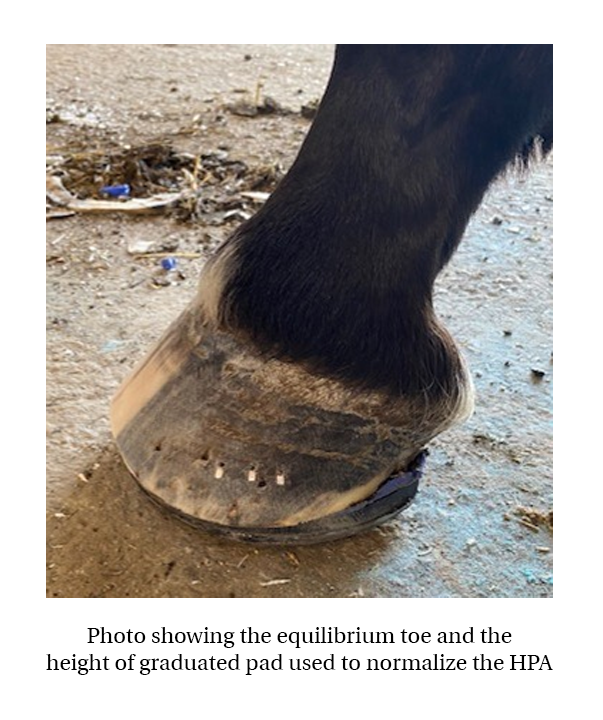 |
Bar ShoesBar shoes may also present an effective way to realign the hoof pastern angle. I usually choose to make my own bar shoes so I can tailor the graduation height and style of bar whether it is a straight bar, inverted bar or heart bar. Generally, I will make my bar shoes from aluminium bar stock, the reasons for this are that it keeps the weight down and allows for the toe to wear faster, again facilitating better breakover. You can also buy bar shoes from your supplier. The advantage of a bar shoe is that it stabilises the of the hoof which is important in cases where the heels are weak or cracked or on occasions when the horse may have other issues associated with low or weak heels. Pour in pad material or DIM can be used in conjunction with bar shoes if desired, however with the stability of the bar I don’t often see the need for it. |
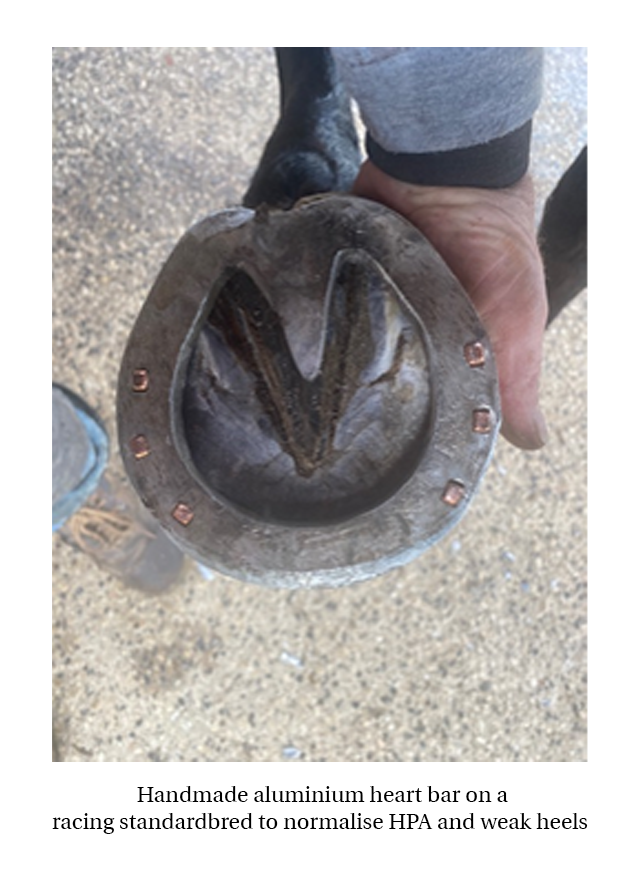 |
Key Take Aways For Maintaining Hoof Pastern Angle Alignment
- Learn more about horse anatomy and biomechanics
- Assess and shoe the horse, not just the foot
- The horse should always be sound after trimming or shoeing
- It’s important that we are always assessing and aligning the angled bones
- Schedule shoeing intervals to correspond with the horse’s hoof growth and work load
- In some cases trimming alone is not able to achieve alignment, so shoeing may be required to correct the hoof pastern angle
I hope you have enjoyed this article.
Until next time, all the best.
Dean Lewis. CJF. AWCF.


